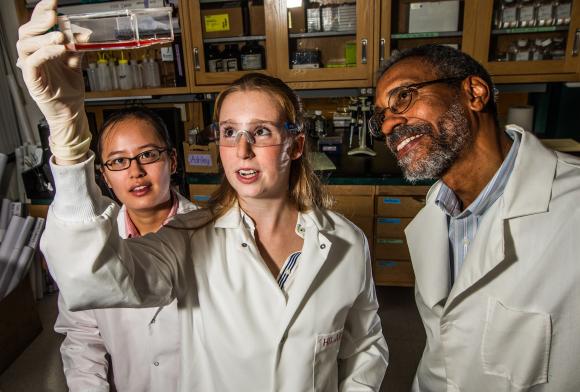PROVIDENCE, R.I. [Brown University] — With the Cubs competing in baseball’s National League championship that night, a “nanosymposium” at the Society for Neuroscience’s annual meeting was not the biggest deal in Chicago Oct. 20. But in 4,400 square feet of the city, at least, a protein called the sigma-2 receptor was the undisputed center of attention.
A passionate community of scientists had gathered in room 405 on the fourth floor of the south building of the McCormick Convention Center to speak, listen, and argue because in 1990 Wayne Bowen led the discovery of sigma-2 at Brown, where he is now chair of the Department of Molecular Pharmacology, Physiology, and Biotechnology. The 135-minute series of nine talks that afternoon affirmed that the discovery had spawned a scientific field. One sign of its vibrancy is that it features its very own roiling controversy regarding sigma-2’s mysterious relationship with another protein. Another is that authors of the research presented there hailed from Rhode Island, Pennsylvania, Wisconsin, Mississippi, Texas, California, the United Kingdom, and Italy.
“I think that that’s what we all strive for,” Bowen said. “We all hope that we will discover something that is interesting to a number of people that will have a long-lasting impact.”
Years of discovery
It may be hard for current Brown students to picture the J. Walter Wilson building — now a bright stack of offices and conference rooms atop the campus post office — as wet lab space, but in the mid-1980s that’s where Assistant Professor Bowen was studying what everyone at the time thought were kappa opioid receptors on neurons in the brains of guinea pigs.
In experiments there, Bowen began to tease out nuances in how the receptors bound various psychiatric drugs and other compounds to the brain cells. He began to work with medicinal chemists to synthesize novel compounds for his work. Over time he found that the pharmacological profile of certain cells, believed to be the same for certain categories of drugs, actually differed. He also found evidence that the receptor proteins involved had different molecular weights. The watershed moment, 25 years ago this fall, was a paper with co-author Susan Hellewell in the journal Brain Research, in which they proposed that these distinctions meant the sigma receptor was in fact a pharmacological “family” of receptors composed of two subtypes. The idea of sigma-2 was born.
The search for sigma-2 continued in cells of other types. In succeeding years Bowen and his collaborators began to find that it was highly present in many cancers such as pancreatic, colon, lung, breast, glioblastoma, melanoma, and some leukemias. Moreover, his lab found, some compounds that bound to sigma-2 receptors set off a cell death process called apoptosis, suggesting that targeting sigma-2 could kill cancer cells. This applied even to those cancers known to be resistant to therapy.

“We all hope that we will discover something that is interesting to a number of people that will have a long-lasting impact.”
“That meant that the sigma-2 receptor might be a broad-spectrum therapeutic target in treating cancer,” he said, “and this finding sort of began to move the thinking of sigma-2 receptors into the cancer field and started to bring researchers who were not working on sigma-2 receptors or who were previously working on sigma receptors in the brain to start to think about cancer.”
Such scientists, including many who were at the nanosymposium in Chicago, began to make their own findings — for instance that receptors are more highly expressed in cells that were rapidly multiplying and spreading than in tumors that were relatively calm. Robert Mach of the University of Pennsylvania proposed that the sigma-2 receptor might even be a biomarker of cancer growth.
In Chicago, one of Bowen’s doctoral students, Cheri Liu, took to the podium at her first national meeting to discuss her contribution to this line of research. She described her experiments showing that a sigma-2-binding compound kills human neuroblastoma cells much more effectively when cells are multiplying and spreading out than when they are quiescently huddled together in a tight clump.
“A sigma-2 therapy might be more relevant in cancer cells that are very rapidly proliferating,” Liu said. “It’s definitely an interesting target.”
Back in the brain, a Pittsburgh-based company called Cognition Therapeutics Inc. has found that the sigma-2 receptor may have a key role in Alzheimer’s disease. The company’s chief science officer, Susan Catalano, has found that a compound that binds with sigma-2 blocks amyloid beta peptides from damaging neurons. The compound has been able to improve brain function in an Alzheimer’s model in mice, according to the company.
It was Catalano who chaired the nanosympsium at the Society for Neuroscience. In a message announcing the event on an SfN message board, she wrote: “Please join us for a significant milestone in the history of neuroscience at SFN’s first-ever nanosymposium focused on the role of the sigma-2 receptor in the neurobiology of health and disease.”
A wide open field
What the nanosymposium contributed to that historical record was not only new findings, like Liu’s, but also wide-open questions.
One of them goes like this: “If expressing the sigma-2 receptor makes cancer cells so vulnerable, why do they express so much of it?”
Bowen’s doctoral student Hilary Nicholson offered a possible answer in her presentation, also a first on a national meeting stage. Her research shows that some synthetic compounds that bind the receptor cause cancer cells to shift their metabolic activity to a type that works well in low-oxygen environments, such as the kind they might experience as they grow and mutate and spread rapidly. Her paper was just published in the Journal of Pharmacology and Experimental Therapeutics.
“Now it may make sense why cancer is overexpressing this thing and we may know why when we’re targeting it, cells are dying: We’re shutting off this important metabolism pathway,” Nicholson said.
So just maybe that question is resolved — and, Nicholson notes, we may be able to use the findings to help other cells when oxygen is running low, as in a stroke.
But an even greater question still looms for sigma-2. No one has yet found a gene for the receptor protein, and Mach has found that it behaves very similarly to another protein PGRMC1. The controversy is whether the two receptors are actually the same, are related components in a larger protein complex, or are similar but distinct proteins. A few of the presentations took on that question directly, offering clear but seemingly opposed evidence.
“This has led to a major controversy which has led to some spirited discussions at poster sessions and so forth,” Bowen said. “Clearly there is some relationship between the two molecules.”
Back at Brown after the meeting, Bowen seemed excited about his journey with sigma-2, even if its very nature had been batted around at the podium. Certainly Bowen’s discovery has spawned many more, both among his own students and among colleagues around the world.
“I tell the undergrads, you never know what your discovery is going to do — and here we are 20 years later still working on the same protein,” Bowen said. “It’s very rewarding.”
Nicholson said she’s excited to be in Bowen’s lab.
“I find his passion for science inspiring and addicting,” she said. “He’s an incredible mentor. He instills in us this belief that what you are doing is important.”
After the nanosymposium, she noted, a reception followed. By her recollection, it was essentially in Bowen’s honor.
Hear excerpts from Bowen's interview for this story below:
